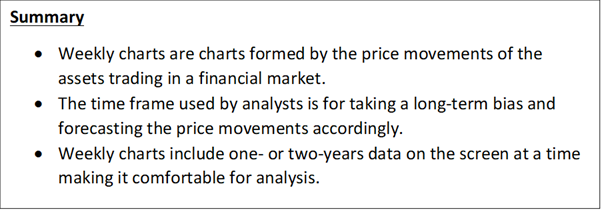Definition
Related Definitions
Weekly Chart
What do you mean by Weekly Chart?
A weekly chart is the information series of value activities for a traded security. Each light, bar, or point on a line addresses the value synopsis for a week of trading on a weekly chart. Candle charts and bar charts are the most well-known sorts of charts utilized by dealers and financial backers.
A weekly chart—set to show in a weekly period—will show high, low, open, and close for the whole week yet won't show the step-by-step trading developments inside that week. Weekly charts can be compared to daily charts.

Copyright © 2021 Kalkine Media
Understanding Weekly Charts
Specialised examiners utilise weekly charts to check the drawn-out pattern of a given resource. A weekly chart can differ in appearance, depending upon what type of chart the examiner decides to utilise.
For instance, a line graph may incorporate the weekly closing price, while a candle chart will show the open, high, low, and close for the 7-day period. This chart development is utilised to provide a drawn-out perspective on security since it incorporates significantly more chronicled value development than an identical period day chart. Frequently, weekly charts can be added to a dealer's watchlist and utilized in contrast with daily charts and volume charts.

Weekly charts include a rundown of information from the entire day of the week. The highest and lowest prices in those five trading meetings, irrespective of the day they traded that week, become the high and low for the weekly market.
Below are the data points which are being observed in charts:
- Organization or Fund being traded: Indicates the specific organization or asset whose value information is being shown.
- Ticker Symbol: Tells you the securities traded ticker image of the organization or asset whose value information is shown.
- Stretch: Charts can be seen in an assortment of clock spans (for example, 2-minute, 5 minutes, every day, and so on. This demonstrates which stretch the chart addresses.
- Bid: Represented by a ‘B’ at the highest point of the chart demonstrates the most exorbitant price at which somebody will purchase this stock or asset.
- Ask: Represented by an at the highest point of the chart, and this shows the most reduced price at which somebody will sell this stock or asset.
- Last: Indicates the price of the Last traded price.
- Net CHG: Indicates the distinction in price between the Last traded and the price at the close of the last trading day.
- Net % CHG: Because a US $1 move in a $50 stock is more critical than a $1 move in a $200 stock. Net % Change all the more precisely addresses the measure of value change for the stock or asset.
- The previous Close: Represented as PC on the highest point of the chart demonstrates the stock price at the close of the last trading day.
- Open: Shown as O on the chart, it is the highest point that demonstrates the price when the market opened that specific day.
- High: Represented as Hi on the highest point of the chart shows the top price a stock has traded till the midday.
- Low: Represented as Lo on the highest point of the chart demonstrates the most reduced value the stock has traded at for the afternoon.
- Volume: The charts are partitioned into two sections; the stock's price and the stock's volume. For the proper stock chart examination and perusing of stock chart designs, both price and volume must be analysed.
- For instance, the stock has fallen more than 5%. At first, it might look exceptionally terrible; however, if the fall is below the average, you might keep on holding the stock because the selling isn't finished by huge retailers who drive the market. The equivalent is the situation when the stock is rising, however, with lower volumes. This ascent in the stock price could be phony since when the huge players enter the stock, there would be a gigantic ascent in the volumes.
A wide range of financial backers may likewise decide to follow monthly charts. Monthly charts will show a much more extensive perspective on security since prices are chart monthly. It can again be helpful to overlay a value chart with a moving average of the prices on all occasions. Moving average probes are followed intently by dealers paying little heed to the time they actually traded. The moving average and moving average envelope channels can likewise be helpful for longer-term financial backers who wish to follow their venture's price in a weekly or monthly chart.
Frequently Asked Questions
- What are the benefits of Weekly Charts?
Weekly charts can assist merchants with security value patterns according to a more extensive point of view than the daily or hourly value activity found in daily or intraday charts. Since a weekly chart can show a year of trading just 52 candles or bars, the patterns, or examples they structure suggest that any conjecture from them will probably most recent a month (or a while). Institutional examiners search for longer-term openings than transient merchants, and weekly charts are bound to apply to what they need to know.
Weekly charts can be utilised related to daily charts to affirm value patterns and purchase/sell signals. Like daily charts, weekly charts can be used to recognise value channels with bullish and negative patterns. Since they provide a visual showcase of prices over time, a few indicators might not be the same as daily value charts or may assist with affirming daily value chart design deductions.
Less dynamic financial backers may likewise utilize weekly charts to pursue and distinguish long-haul value directions in the protections they follow. Numerous financial backers will see weekly charts on the protections they have put resources into to look for changes in long-haul patterns or signals that the venture might be possibly starting a downtrend.
- What is the difference between daily and weekly charts?
The daily charts are supposed to be useful for dealers searching for volume and value activity on an intraday premise. The stocks on daily charts are considered to be giving a breakout when it penetrates the 50-day line on one or the other side. Then again, for long-haul financial backers, weekly charts are great. These charts figure the drawn-out price of stock alongside its pattern. It also monitors the financial backer's feelings, as they can make wrong choices on the daily charts.
